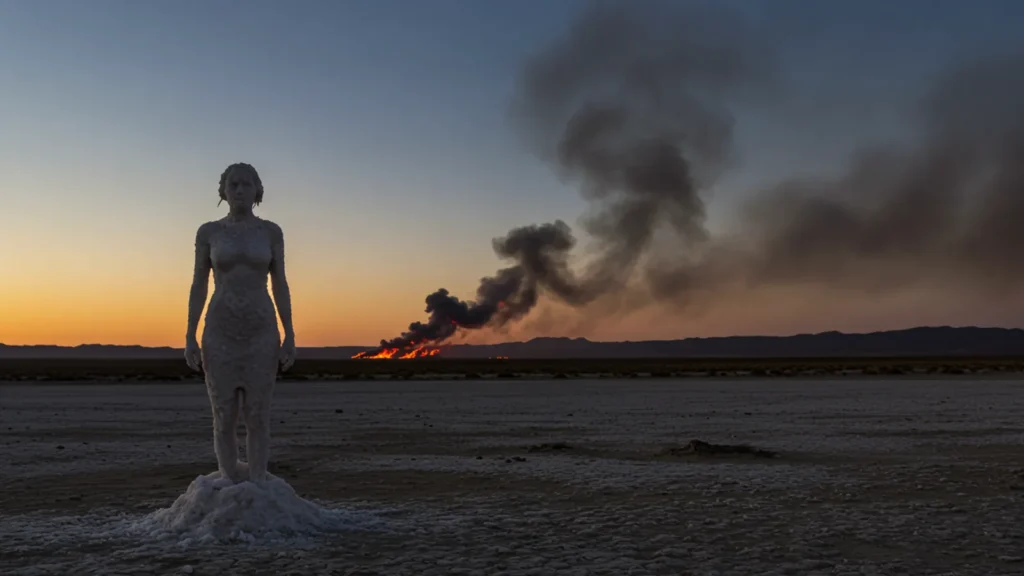The story of Sodom and Gomorrah is one of the most impactful passages in the Bible, marked by mystery, judgment, and profound lessons. Located in a prosperous region near the Dead Sea, these cities became a symbol of moral corruption and the consequences of turning away from God.
The biblical account is not only about destruction, but also about mercy, intercession, and obedience. By learning this narrative, we can better understand divine justice and reflect on choices that shape the destiny of people and nations.
Table of Contents — Straight to the Point
Quick Summary
- Sodom and Gomorrah: two cities known for their wealth but also for their wickedness.
- Abraham intercedes: he asks God to spare the righteous.
- Visit of the angels: they go to Sodom and are welcomed by Lot.
- Destruction: fire and sulfur fall from heaven, destroying the cities.
- Lessons: obedience, divine justice, and intercession.

How It Happened
The Context
According to the narrative, Sodom and Gomorrah were cities on the Jordan plain, known for their wealth but also for moral corruption and injustice. The outcry against the sin of these cities reached God, who decided to judge them.
Abraham Intercedes
Before the destruction, God revealed to Abraham what was going to happen. Abraham then interceded, asking that if there were righteous people there, the cities would not be destroyed. He began by asking for fifty righteous and reduced the number down to ten. God promised that if there were ten righteous, He would spare the cities. But not even that number was found.
The Visit of the Angels
Two angels were sent to Sodom and were received by Lot, Abraham’s nephew. Lot offered hospitality, but the men of the city surrounded his house and demanded that the visitors be handed over to them so they could abuse them. Lot tried to protect his guests and even offered his own daughters in desperation — an extreme gesture tied to the ancient code of hospitality. The angels then struck the attackers with blindness and rescued Lot and his family.
The Escape
The angels ordered Lot, his wife, and his two daughters to leave the city quickly without looking back. At daybreak, fire and sulfur rained down from heaven, destroying Sodom, Gomorrah, and the entire plain.
Lot’s Wife
During the escape, Lot’s wife disobeyed and looked back, being turned into a pillar of salt. This detail is remembered as a symbol of disobedience and attachment to the past.

The Fate of Sodom and Gomorrah
The cities were completely destroyed. The biblical account says that neither plants, nor life, nor buildings remained. Today, many scholars associate the destruction with the Dead Sea region, where there are signs of ancient natural catastrophes, but there is no definitive archaeological proof.
Lessons from Sodom and Gomorrah
⚖️ God’s Justice
The destruction shows that God does not ignore persistent wickedness.
🙏 The Power of Intercession
Abraham showed that we can intercede for others, seeking mercy.
👁️ Obedience
Lot’s wife is remembered as a warning not to disobey divine instructions.
🏠 Hospitality
While the men of the city sought to abuse the visitors, Lot welcomed them, reinforcing the importance of biblical hospitality.
Facts about Sodom and Gomorrah
✦ The episode is cited not only in Genesis, but also in other books of the Bible such as Isaiah, Ezekiel, and Jude.
✦ In the New Testament, Jesus recalls Sodom as an example of judgment (Matthew 11:23–24).
✦ The expression “sin of Sodom” was used for centuries as a synonym for practices contrary to God’s will.
✦ The Dead Sea, near the region, is the lowest point on Earth and has no visible life in its salty waters.
Where the Story of Sodom and Gomorrah Is in the Bible
The main account of Sodom and Gomorrah is in the Book of Genesis, chapters 18 and 19.
- In Genesis 18, God reveals to Abraham the decision to investigate the outcry against the cities and announces judgment. In this chapter the famous intercession of Abraham takes place, asking that the righteous be spared.
- In Genesis 19, the angels arrive in Sodom, are welcomed by Lot, and the entire sequence of destruction unfolds: the attempted invasion of the house, the family’s escape, and the fall of fire and sulfur upon the cities.
Beyond Genesis, other books of the Bible also mention Sodom and Gomorrah as examples of judgment and spiritual warning:
- Isaiah 13:19 – speaks of the fall of Babylon, comparing it to the destruction of Sodom.
- Ezekiel 16:49–50 – mentions the pride, abundance, and lack of compassion among Sodom’s inhabitants.
- Luke 17:28–29 – Jesus recalls the episode as a warning sign for the last days.
- Jude 1:7 – compares Sodom and Gomorrah to the fate of those who turn away from God.
This set of references shows that the story is not just an isolated event in Genesis, but a milestone that runs throughout the Bible as a symbol of warning and reflection.
Conclusion
The story of Sodom and Gomorrah is one of the most striking in the Bible. It shows the danger of moral corruption, but also reveals the importance of intercession, obedience, and trust in God.
More than a simple ancient account, this narrative continues to inspire reflections on justice, mercy, and the choices each person makes in life.
READ ALSO:
- Jeremiah 33:3 – God’s Call to Answer
- Matthew 17:20 Faith That Moves Mountains – Have Faith!
- Joshua 1:9: The Promise of Strength and Courage for Your Life
FOLLOW US ON FACEBOOK